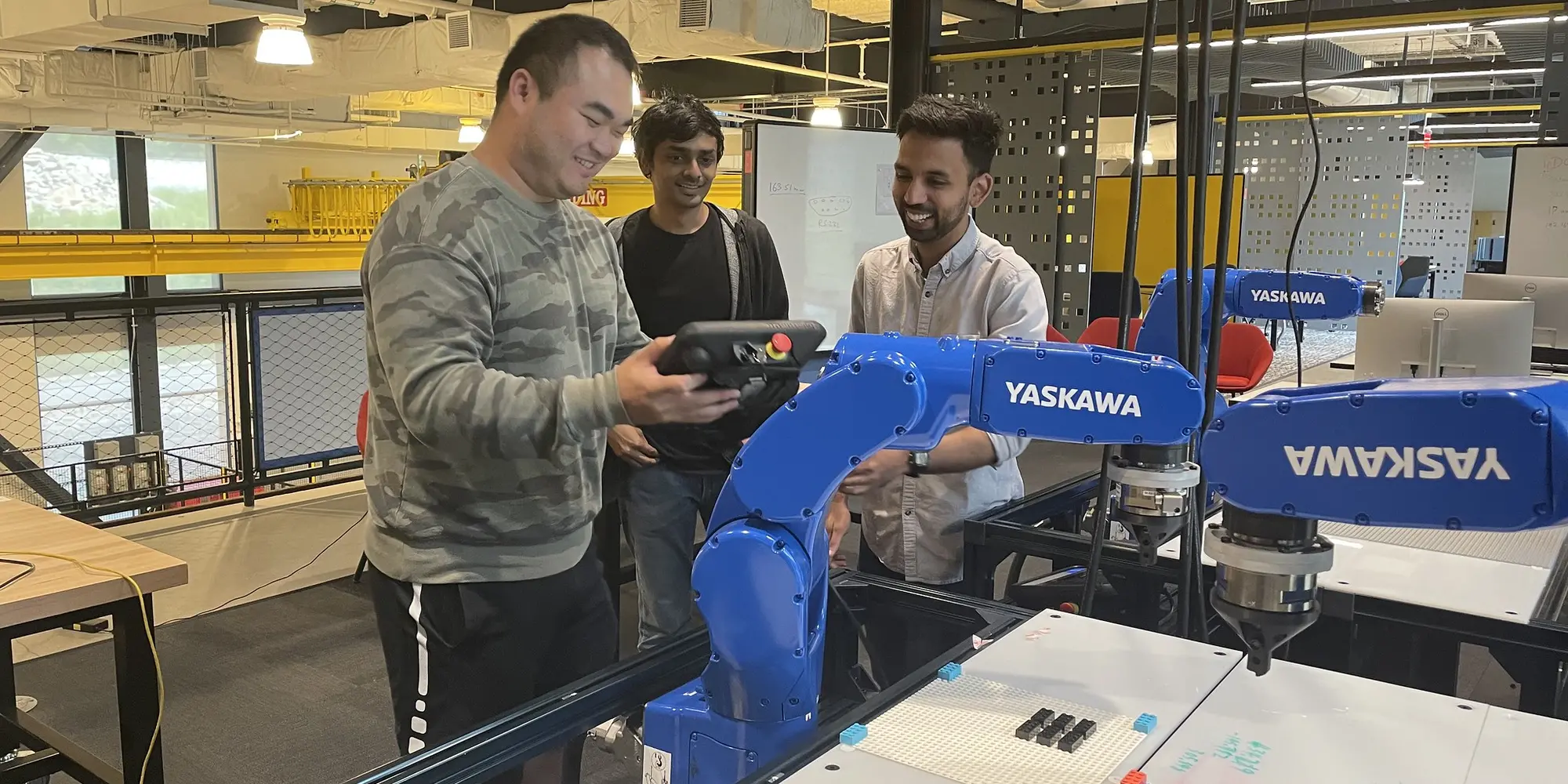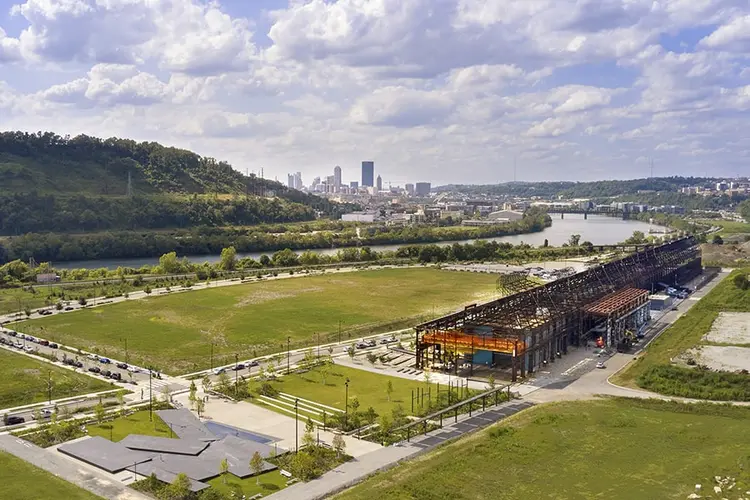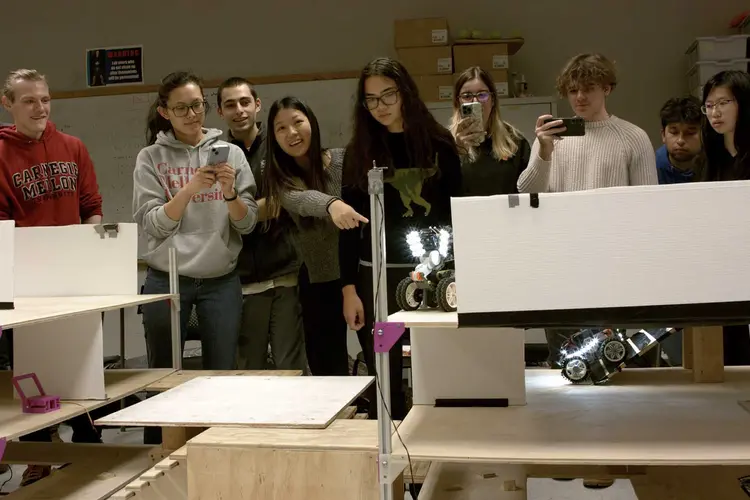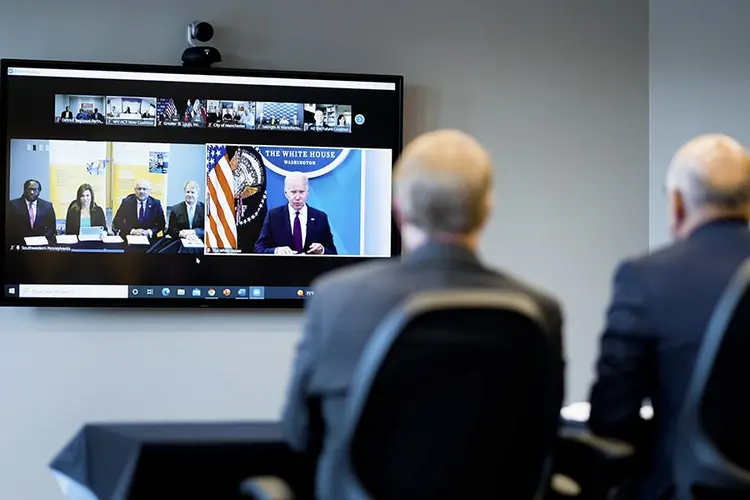
Industrial Robots Build with Lego Bricks at Mill 19
Media Inquiries
Since the celebrated opening of Mill 19(opens in new window) four years ago, Carnegie Mellon University’s Manufacturing Futures Institute(opens in new window) (MFI) has been steadily outfitting the advanced manufacturing facility with state-of-the-art equipment to support its expanding research efforts and fulfill its mission to inspire, engineer and lead technological and workforce advances for agile, intelligent, efficient, resilient and sustainable manufacturing.
The latest addition to the facility is a flexible robotic test bed. Four six-axis industrial robot arms equipped with multiple sensors surround a worktable in the second floor mezzanine area of MFI’s Mill 19 Building A location. Ceiling-mounted programmable light curtains provide safety by sensing when humans get too close to the robots, and the system then immediately disables their motion.
Designed initially to test and advance robotic assembly and disassembly using Lego bricks, the test bed is also capable of being used to study other robotic functions in manufacturing, such as material handling, quality inspection and more complex manipulation to thread small fasteners, to route electrical wiring and even to assemble food items into snack packs.
Two autonomous mobile robots will be used to deliver Lego bricks to and from the robot arms as well as in research aimed at training robots to move other materials and supplies efficiently and safely throughout a facility.
“We’ve built this test bed to accommodate both current and future research,” said Gary Fedder(opens in new window), MFI faculty director. “It is flexible enough to support current research efforts as well as speculative projects that will be undertaken to compete for new federal awards and other future sources of funding.”
Users will need to reserve time to work with the robotic test bed like students and faculty schedule time to conduct research on metals 3D printing in the additive manufacturing facilities and equipment at Mill 19. There are several research projects underway to advance the robots’ ability to assemble and disassemble parts, to build a sharable codebase and to support associated factory digital twin research.
Lego bricks were chosen as the building material because they are not only safe and fun to play with, but they can also be used for constructing complex geometries that researchers need to test and build data sets. They are also ideal for creating simple structures that can be used to demonstrate robotic and digital manufacturing capabilities to students and industry professionals who visit Mill 19.
Shobhit Aggarwal, who earned his master’s degree in integrated innovation for products and services from CMU earlier this year, was hired as an advanced manufacturing engineer by MFI to oversee the test bed. In addition to coordinating its activity, he will also help develop short courses to demonstrate to industry partners and visitors how robots can be employed in assembly/disassembly functions, a project funded in part by Southwestern Pennsylvania’s federal Build Back Better Regional Challenge initiative.
“The test bed is essentially a production floor equipped with cutting-edge safety systems, logistics, a manufacturing execution system and industrial robots, providing an almost real-life environment to research, test and gather data to develop groundbreaking technologies for manufacturing futures,” Aggarwal said.
Nearly all the research at Mill 19 is being conducted to develop advanced manufacturing technologies. In addition to additive manufacturing and robotics research, the individual equipment and project cells like the robotic test bed act as subjects for digital twin technology research.
Digital twin technology used in manufacturing creates virtual, interoperable models of equipment, production lines or entire factories that update to physical twin data in order to aid in product design and development, process optimization, predictive maintenance, quality control, training and simulation, and real-time monitoring and control.
The digital twin of the test bed will generate real-time data related to the equipment performance, and provide insights that can make the system more efficient, agile and smart. As one of multiple project cells throughout the Mill 19 facility, the test bed will eventually be incorporated into a broader digital twin of the entire facility.
A growing codebase of utilities and application programming interfaces associated with the test bed will enable both MFI researchers and visitors to more rapidly use the robots and focus on innovation.
The open-source software dubbed “MFI Codebase” will encompass an entire collection of source code, files, documentation, assets and other resources for the software that will be used with other equipment and project cells throughout the facility.
A large video monitor near the test bed site that can be used for presentations will eventually serve also as a note board to display and curate data streams of all the equipment in the building.
These advanced technologies require the expertise of a wide range of researchers from the College of Engineering(opens in new window), as well as those working in computer science and other academic areas throughout the university. The test bed area is also outfitted with multiple work areas designed to accommodate the interdisciplinary teams who meet and educate visitors at Mill 19.
“The remarkable combination of human intelligence, digital innovation and advanced manufacturing technology and equipment at Mill 19 ensures MFI’s ability to conduct groundbreaking research, educate manufacturing innovators and work with partners to translate our discoveries into industry relevant applications,” Fedder said.


